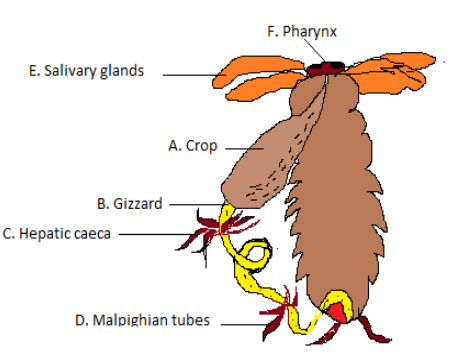
Draw an alimentary canal of cockroach. Label any six parts.
Answer
501k+ views
Hint:The digestion of food would take place in the cavity specialized, or combined together. Alimentary canal is also called digestive tract and it is the pathway by which the food enters the body and solid waste goes out from the body.
Complete answer:

Digestion is defined as the process in which breakdown of food takes place into smaller components. Parts of the alimentary canal of cockroach have been divided into 3 sections:- fore-gut, mid-gut, hind-gut.
1) Salivary glands:-The salivary glands of cockroach acini with ion transporting cells. It has a duct system with a pair of reservoirs. There are 2 salivary ducts that join into a common duct. 2) Gizzard:- The gizzard is a muscular stomach. It has a sharp tooth like structure that helps in grinding the food into minute pieces. 3) Crop:- Food moves to the esophagus and then into the crop.
4)Malpighian tubules: It is the excretory organ of the cockroach. It is mainly found between midgut and hindgut. It helps in removing the excretory waste from the haemolymph. Hepatic caeca: It is the ring of mainly 8 blind tubules. The function of hepatic caeca is that they help to secrete digestive juices to facilitate digestion. It is present at the junction of the fore-gut and the midgut. 5)Ileum: -It is a small, narrow, tabular part. It helps in absorbing the remaining nutrients which were not absorbed by the crop. It helps in neutralizing all the nutrients from the food contents. Colon:- it is a highly coiled structure. It is considered to be an important site. For symbiotic digestion. It has the highest diversity and density of bacteria of all the gut compartment.
Note: Cockroach is omnivorous. The nutrition in cockroaches is holozoic. It can eat all kinds of organic matter. Cockroaches can live 8 days without their head. Digestion of food takes place via an alimentary canal and waste food goes out of the body.
Complete answer:

Digestion is defined as the process in which breakdown of food takes place into smaller components. Parts of the alimentary canal of cockroach have been divided into 3 sections:- fore-gut, mid-gut, hind-gut.
1) Salivary glands:-The salivary glands of cockroach acini with ion transporting cells. It has a duct system with a pair of reservoirs. There are 2 salivary ducts that join into a common duct. 2) Gizzard:- The gizzard is a muscular stomach. It has a sharp tooth like structure that helps in grinding the food into minute pieces. 3) Crop:- Food moves to the esophagus and then into the crop.
4)Malpighian tubules: It is the excretory organ of the cockroach. It is mainly found between midgut and hindgut. It helps in removing the excretory waste from the haemolymph. Hepatic caeca: It is the ring of mainly 8 blind tubules. The function of hepatic caeca is that they help to secrete digestive juices to facilitate digestion. It is present at the junction of the fore-gut and the midgut. 5)Ileum: -It is a small, narrow, tabular part. It helps in absorbing the remaining nutrients which were not absorbed by the crop. It helps in neutralizing all the nutrients from the food contents. Colon:- it is a highly coiled structure. It is considered to be an important site. For symbiotic digestion. It has the highest diversity and density of bacteria of all the gut compartment.
Note: Cockroach is omnivorous. The nutrition in cockroaches is holozoic. It can eat all kinds of organic matter. Cockroaches can live 8 days without their head. Digestion of food takes place via an alimentary canal and waste food goes out of the body.
Recently Updated Pages
Master Class 12 Business Studies: Engaging Questions & Answers for Success

Master Class 12 English: Engaging Questions & Answers for Success

Master Class 12 Social Science: Engaging Questions & Answers for Success

Master Class 12 Chemistry: Engaging Questions & Answers for Success

Class 12 Question and Answer - Your Ultimate Solutions Guide

Master Class 11 Economics: Engaging Questions & Answers for Success

Trending doubts
Draw a labelled sketch of the human eye class 12 physics CBSE

a Tabulate the differences in the characteristics of class 12 chemistry CBSE

Which one of the following is a true fish A Jellyfish class 12 biology CBSE

Why is the cell called the structural and functional class 12 biology CBSE

Differentiate between homogeneous and heterogeneous class 12 chemistry CBSE

Write the difference between solid liquid and gas class 12 chemistry CBSE




